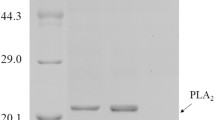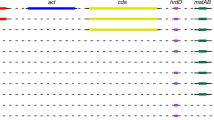Abstract
Streptomyces lividans has shown potential as an expression system for heterologous proteins. Overexpression of proteic factors important for heterologous protein production is a valuable approach to improve yields of such proteins. Comparative transcriptomic analysis revealed that several genes were differentially expressed in strains involved in heterologous protein production. For instance, the gene-encoding phosphoenolpyruvate carboxykinase (pepck) showed a significant twofold change in recombinant S. lividans producing human tumour necrosis factor-alpha (hTNF-α). The effect of pepck overexpression on S. lividans TK24 and its hTNF-α producing recombinant was thus investigated in bench-top fermenters. Results obtained revealed that pepck overexpression resulted into a twofold increase in specific PEPCK activity during growth. This overexpression is correlated with slower growth rate, reduced excretion of pyruvate and less alkalinisation of the growth medium when compared with the control strain. After 26 h of fermentation, hTNF-α yields were enhanced (up to 1.7-fold) in the pepck-overexpressing S. lividans TK24, demonstrating that this metabolic engineering approach is indeed promising for heterologous protein production.



Similar content being viewed by others
References
Aich S, Imabayashi F, Delbaer LTJ (2003) Expression, purification, and characterization of a bacterial GTP-dependent PEP carboxykinase. Protein Exp Purif 31:298–304
Anné J, Van Mellaert L (1993) Streptomyces lividans as host for heterologous protein production. FEMS Microbiol Lett 114:121–128
Anné J, Maldonadoa B, Van Impe J, Van Mellaert L, Bernaerts K (2012) Recombinant protein production and streptomycetes. J Biotechnol 158(4):159–167
BD Biosciences Technical Manual. Adv Bioprocess 3rd edn. pp. 30–31. http://www.bdbiosciences.com/documents/Beef_Extract.pdf. Accessed 24 Nov 2011
Binnie C, Cossar JD, Stewart DIH (1997) Heterologous biopharmaceutical protein expression in Streptomyces. Trends Biotechnol 15:315–320
Borodina I, Krabben P, Nielsen J (2005) Genome-scale analysis of Streptomyces coelicolor A3(2) metabolism. Genome Res 15:820–829
Bradford MM (1976) A rapid and sensitive method for the quantitation of microgram quantities of protein utilizing the principle of protein-dye binding. Anal Biochem 72:248–254
D’Huys PJ, Lule I, Van Hove S, Vercammen D, Wouters C, Bernaerts K, Anné J, Van Impe JFM (2011) Amino acid uptake profiling of wild type and recombinant Streptomyces lividans TK24 batch fermentations. J Biotechnol 152:132–143
De Keersmaeker S, Vrancken K, Van Mellaert L, Lammertyn E, Anné J, Geukens N (2006) Evaluation of TatABC overproduction on Tat- and Sec-dependent protein secretion in Streptomyces lividans. Arch Microbiol 186:507–512
Delbaere LTJ, Sudom AM, Prasad L, Leduc Y, Goldie H (2003) Structure/function studies of the phosphoryltransfer enzyme: phosphoenolpyruvate carboxykinase. Cell Mol Biol Lett 8(2):519–521
Kieser T, Bib M, Buttner M, Chater K, Hopwood D (2000) Practical Streptomyces Genetics. The John Innes Foundation, Norwich
Korn F, Weingärtner B, Kutzner HJ (1978) A study of twenty actinophages: morphology, serological relationship and host range. In: Freerksen E, Tarnok I, Thumin JH (eds) Genetics of the actinomycetes. Fisher G, Stuttgart, pp 251–270
Lammertyn E, Van Mellaert L, Schacht S, Dillen C, Sablon E, Van Broekhoven A, Anné J (1997) Evaluation of a novel subtilisin inhibitor gene and mutant derivatives for the expression and secretion of mouse tumour necrosis factor alpha by Streptomyces lividans. Appl Environ Microbiol 63:1808–1813
Mittra P, Chakrabartty PK (2005) An extracellular protease with depilation activity from Streptomyces nogalator. J Sci Ind Res 64:978–983
Okanishi M, Suzuki K, Umezawa H (1974) Formation and reversion of streptomycete protoplasts: cultural condition and morphological study. J Gen Microbiol 80:389–400
Palacín A, ParroV GN, Anné J, Mellado RP (2002) SipY is the Streptomyces lividans type I signal peptidase exerting a major effect on protein secretion. J Bacteriol 184:4875–4880
Petersen S, Mack C, De Graaf AA, Riedel C, Eikmanns BJ, Sahm H (2001) Metabolic consequences of altered phosphoenolpyruvate carboxykinase activity in Corynebacterium glutamicum reveal anaplerotic regulation mechanisms in vivo. Metab Eng 3:344–361
Petinate SDG, Martins RM, Coelho RRR, Meirelles MNL, Branquinha MH, Vermelho AB (1999) Influence of growth medium in proteinase and pigment production by Streptomyces cyaneus. Res Note Mem Inst Oswaldo Cruz 94(2):173–177
Pozidis C, Lammertyn E, Politou AS, Anné J, Tsiftsologou AS, Sianidis G, Economou A (2001) Protein secretion biotechnology using Streptomyces lividans: large-scale production of functional trimeric tumour necrosis factor alpha. Biotechnol Bioeng 72:611–619
Riedel C, Rittmann D, Dangel P, Möckel B, Petersen S, Sahm H, Eikmanns BJ (2001) Characterization of the phosphoenolpyruvate carboxykinase gene from Corynebacterium glutamicum and significance of the enzyme for growth and amino acid production. J Mol Microbiol Biotechnol 3(4):573–583
Sepúlveda C, Poch A, Espinoza R, Cardemil E (2010) Electrostatic interactions play a significant role in the affinity of Saccharomyces cerevisiae phosphoenolpyruvate carboxykinase for Mn2+. Biochim 92:814–819
Shih I-L, Shen M-H (2006) Optimization of cell growth and poly(e-lysine) production in batch and fed-batch cultures by Streptomyces albulus IFO 14147. Process Biochem 41:1644–1649
Sianidis G, Pozidis C, Becker F, Vrancken K, Sjoeholm C, Karamanou S, Takamiya-Wik M, Van Mellaert L, Schaefer T, Anné J, Economou A (2006) Functional large-scale production of a novel Jonesia sp. xyloglucanase by heterologous secretion from Streptomyces lividans. J Biotechnol 121:498–507
Vrancken K (2009) Rational engineering of Streptomyces lividans for the improved secretion of recombinant proteins. Dissertation, Katholieke Universtiteit Leuven
Vrancken K, De Keersmaeker S, Geukens N, Lammertyn E, Anné J, Van Mellaert L (2007) PspA overexpression in Streptomyces lividans improves both Sec- and Tat-dependent protein secretion. Appl Microbiol Biotechnol 73:1150–1157
Yuratmoko D, Mubarik NR, Meryandini A (2007) Screening of proteolytic enzymes of Streptomyces sp. local strain and their characterization. Microbiol Indones 1(2):69–73
Zamboni N, Maaheimo H, Szyperski T, Hohmann H-P, Sauer U (2004) The phosphoenolpyruvate carboxykinase also catalyzes C3 carboxylation at the interface of glycolysis and the TCA cycle of Bacillus subtilis. Metab Eng 6:277–284
Acknowledgments
This research is supported by projects: Research Foundation of Flanders (FWO-G-00352.09), Center-of-Excellence Optimization in Engineering (OPTEC, PFV/10/002), SCORES4CHEM of the Katholieke Universiteit Leuven (KP/09/005), Research Council of the Katholieke Universiteit Leuven (DBOF/08/033) and by the Belgian Program on Interuniversity Poles of Attraction, initiated by the Belgian Federal Science Policy Office, by FP6-EU project no. LSHC-CT-2006-037834, and in the framework of ERA-IB project EIB.08.013. J. Van Impe holds the Chair Safety Engineering sponsored by the Belgian Chemistry and Life Sciences Federation—Essenscia.
Author information
Authors and Affiliations
Corresponding author
Electronic supplementary material
Below is the link to the electronic supplementary material.
ESM 1
(PDF 48 kb)
Rights and permissions
About this article
Cite this article
Lule, I., Maldonado, B., D’Huys, PJ. et al. On the influence of overexpression of phosphoenolpyruvate carboxykinase in Streptomyces lividans on growth and production of human tumour necrosis factor-alpha. Appl Microbiol Biotechnol 96, 367–372 (2012). https://doi.org/10.1007/s00253-012-4182-1
Received:
Revised:
Accepted:
Published:
Issue Date:
DOI: https://doi.org/10.1007/s00253-012-4182-1




